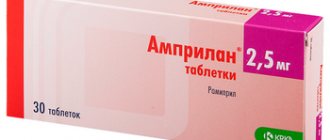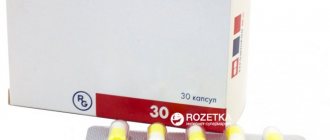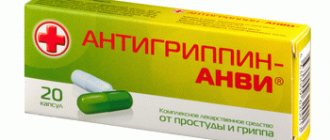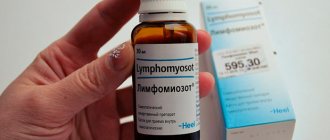Gliformin is a medicine that belongs to the biguanides used in the treatment of diabetes mellitus. The pharmacological agent is characterized by a hypoglycemic effect. It is used orally, mainly for type 2 diabetes; for type 1 diabetes, the medication is used as part of a comprehensive treatment. The pharmacological drug, in addition to its hypoglycemic effect, promotes peripheral utilization. Glucose with a simultaneous decrease in its absorption by the intestines and increases the sensitivity of cells to insulin.
Pharmacological group
Gliformin is characterized by a hypoglycemic effect and belongs to the group of bigunides. Intended for oral administration. It is able to inhibit hepatic gluconeogenesis, reduce the absorption of glucose from the gastrointestinal tract, and also enhance its peripheral utilization against the background of an increase in insulin sensitivity of cells. The drug does not affect the process of insulin production by beta cells of the pancreas. Also, when taking the drug, there is a decrease in the concentrations of triglycerides and LDL in the bloodstream. Normalization or decrease in the patient’s body weight may occur.
The active component, metformin, is quickly absorbed from the gastrointestinal tract. The highest concentrations in the bloodstream are observed after 2-2.5 hours from the moment of administration. The bioavailability of the drug is 50-60%. The pharmacological agent does not actually bind to blood proteins. There is an accumulation of the drug substance in the salivary glands, liver and kidneys. The active compound is excreted virtually unchanged by the kidneys.
Reviews
Opinion of a practicing endocrinologist and patient reviews:
“Metformin hydrochloride-based drugs have gained well-deserved popularity for the treatment of diabetes mellitus. Unlike a number of other antidiabetic drugs, they do not stimulate beta cells, which are already overloaded in diabetics (especially those with many years of disease), and do not cause an increase in insulin in the blood, which prevents the consumption of their own fat deposits, which is important for diabetics, since this disease goes hand in hand with obesity and they endocrine potentiate each other. The drug stimulates the absorption of blood glucose by tissues, due to which they receive more nutrients and tissue metabolism improves. This makes the drug excellent for mono- or combination treatment. The only problem may be lactic acidosis in case of overdose. To avoid it, you need to increase the dose slowly, listening to how you feel, and only if there are sufficient reasons. Using long-acting forms will also help minimize the likelihood of lactic acidosis.”
Konstantin Valerievich, endocrinologist
“I have been taking Gliformin for more than two years, since my pension does not allow me to spend money on imported analogues. I take 2 grams a day, one tablet for breakfast and one tablet for dinner. Sugar remains stable and normal; it can only rise when drinking alcohol. In the first weeks of use, diarrhea may occur, which is an addictive reaction to preventing the absorption of sugars. This symptom goes away on its own.”
Alexander, 37
Indications for use
Gliformin has 2 main indications for use:
- In patients with type 2 diabetes mellitus, if the therapeutic effect provided by diet therapy and sulfonylurea is insufficient.
- In patients with type 1 diabetes mellitus as an adjuvant as part of complex therapy.
for adults
For patients in the adult age group, the medication is prescribed solely for indications. Unauthorized use of medication unnecessarily and without direct prescription is not recommended.
for children
The medication is not used in pediatric practice. For patients under 18 years of age, it is not recommended to use a pharmacological agent unless strictly necessary and prescribed by a treating specialist.
for pregnant women and during lactation
During pregnancy, the use of Gliformin is not recommended, as there is a risk of harming the health of the unborn child. Use during breastfeeding requires stopping the baby from feeding breast milk and transferring it to specialized artificial formulas.
Reviews Turkish tablets for diabetes Glukofen (Glucofen) 1000 mg 100 pcs
The drug Glucofen, which has the active component metformin hydrochloride, is one of the most effective and safe drugs used in the healthcare system. Glucofen is a Turkish analogue of drugs known in Kazakhstan and Russia, such as Metformin and Glucophage, and is used to treat type 2 diabetes.
Glucofen helps the body increase tissue sensitivity to insulin, increases peripheral glucose uptake, increases the oxidation of fatty acids, while reducing the absorption of glucose from the gastrointestinal tract.
The most important effect of Glucofen is the suppression of the production of glucose by the liver, which is typical for type 2 diabetes mellitus, especially with a complication such as obesity. By reducing insulin levels in the body, Glucofen helps get rid of fat deposits.
It is due to this action that many people use Glucofen as diet pills. Glucofen prevents the development of cardiovascular diseases and complications of diabetes.
More details
Turkish tablets for diabetes mellitus Glukofen (Glucofen) 1000 mg 100 pcs.
Natalya Nikolaevna
Good tablets, I have been using them for a long time and regularly. Makes my life a lot easier
Nikolai Alexandrovich
Compared to other similar drugs, glucofen has a milder and more gentle effect on the body. At least that's how I feel. For example, when using glucofen, I did not experience heartburn at all, as was the case when taking other drugs of this type.
Olga
It also seemed to me that the Turkish drug has a milder effect, although its effectiveness is no worse than other tablets
Saule
On an empty stomach the sugar is 7.6, 2 hours after eating the sugar is 9.9. I take Glucofen 1000 mg 2 times a day. Can the dose be increased?
Administration of the pharmacy “Tibetan Monk”
Hello, Sayle! We think that you have come to the wrong address. We have already written that self-medication is harmful and dangerous to health. Based on tests, only a doctor can determine the correct dosage of the drug.
Tolkyn Mirasovna
Hello! I have type 2 diabetes. I take Glucofen. At first I took 500 mg in the morning and evening, then the doctor increased my dose to 1500 mg per day. I switched to low carb eating.
Sugar was managed to be compensated, and it even dropped slightly below the normal value of 5.5. I just have 5 units now. stable. So glucofen works very well.
Now the doctor has reduced my dose again to 1000 mg per day
Orazbek
I have had type 2 diabetes for 10 years. I don’t go to the doctor anymore because... our communication boils down to measuring blood pressure and writing a prescription for metomorphine. I recently switched to glucofen, 1000 mg in two doses of 500.
Now, basically, fasting sugar is at the same level from 7 to 7.5. I do exercises every morning and a walk every day. I'm a little overweight, but somehow I can't seem to lose weight.
I try not to eat forbidden foods.
Nazgul Serikovna
I am 57 years old and have had type 2 diabetes for 4 months. Recently I independently changed Russian gliformin to Turkish glucofen. While taking gliformin, I suffered from nausea and constipation for all 4 months. On glucofen the gastrointestinal tract returned to normal
Anton
Six months ago I was diagnosed with type 2 diabetes. I have type 2 obesity, I lead a sedentary lifestyle, my sugar level is 6.5. At first I took 25 mg of Eutirox, recently the doctor increased the dose to 50 mg.
A month ago I had a cholelithiasis surgery, at the moment my fasting sugar is 5.4-5.7 and up to 6.0 after eating if I don’t go for a walk. And after walking, sugar is at 5.7. Now the doctor prescribed me 500 mg glucofen tablets in the evening.
Thanks to them, my sugar levels are now normal.
Catherine
Hello! My mother is 65 years old, diagnosed with prediabetes due to obesity, fasting sugar from 4.6 to 6.2. She was prescribed glucofen and took 1000 mg of it 2 times a day for three months. My general condition has improved greatly. But I didn’t lose much weight – 8 kg
Anatoly
Hello! I am 47 years old. At the beginning of the summer, I had a heart attack at work and was taken to the hospital by ambulance. During the tests, it turned out that my sugar was still elevated (7.6). Diagnosed with prediabetes.
Now I take the drug Glucofen 500 mg twice a day. I'm on a diet. Sugar dropped to 5.5 units. Now I’m thinking about taking a break from taking the drug and I doubt whether this is right.
But I don’t want to go to the doctor with this question.
Amangul
Two years ago, I was diagnosed with type 2 diabetes, thanks to glucofen tablets and diet, my sugar returned to normal, now 2 hours after eating it is 5.5. I also lost 12 kg in a year. But the weight does not decrease anymore, it stays in place. I would like to lose at least 8 more kilograms, but I don’t know how
Diana
My father is 58 years old, he has type 2 diabetes, sugar is 12. The doctor prescribed Glucofen 1000 twice a day, half a tablet. Dad feels much better. A diet was also recommended, which he now follows. Its weight is very large - 130 kg. Now he has started to lose weight quite quickly, he has already lost 14 kg. We hope everything will be fine
- If you want to stop a certain slide, then move the cursor over it.
- If you want to go to the page of the product shown on the slide, just click on the slide
All preparations from the Tibetan Monk pharmacy are completely natural, made in China based on modern extraction technologies from medicinal herbs or ingredients of animal origin. Therefore, the drugs are of high quality, effective and safe to use.
Source: https://kitayskaya-apteka-kostanay.asia.kz/letschebnie-preparati-tabletki/diabet-tabletki-glukofen.html?page=reviews
Contraindications
Gliformin has a fairly wide range of contraindications that make its use unacceptable:
- Diabetic ketoacidosis, diabetic precoma and coma.
- Disorders of the functioning of the kidneys and liver.
- Acute diseases that create a risk of kidney dysfunction, dehydration, fever, severe infectious diseases, hypoxia.
- Severe manifestations of chronic and acute diseases that can lead to tissue hypoxia.
- Severe injuries and surgical procedures.
- Chronic alcoholism or acute poisoning from alcohol-containing products.
- Use of the drug 2 days before and for 2 days after performing radioisotope or x-ray examinations using iodine-containing contrast.
- Lactic acidosis, including a history.
- Periods of pregnancy and breastfeeding.
- Excessive individual sensitivity of the body to the components of the drug.
- Compliance with a dietary diet whose daily calorie content is less than 1000 kcal/day.
Compound
1 tablet contains:
Active substance: active substance: metformin hydrochloride in terms of 100% substance – 1000 mg;
Excipients: methyl methacrylate and ethyl acrylate copolymer [1: 2] in terms of dry matter - 72 mg, colloidal silicon dioxide - 29.7 mg, hypromellose - 319, microcrystalline cellulose - 22 mg, magnesium stearate - 7.3 mg.
Shell composition: hypromellose-2910 – 39.6 mg, macrogol-6000 – 7.2 mg, glycerol – 3.6 mg, talc – 4.8 mg, titanium dioxide – 4.68 mg, iron oxide yellow dye – 0, 12 mg.
Applications and dosages
The required frequency of administration is determined by the treating specialist based on the patient’s clinical picture. It is prohibited to violate the dosage instructions and other aspects of taking Gliformin.
for adults
The initial dose of the medication is 0.5-1g/day or 0.85g 1 time/day. After 10-15 days, a gradual increase in dosage is possible, subject to glycemic monitoring. The maintenance dose of the medication is often 1.5-2 g/day. The highest daily dose is 3 g/day. To reduce the number of adverse reactions, it is advisable to divide the daily dose into 2-3 doses.
In elderly patients, the maximum daily dose should not be more than 1 g. In severe metabolic disorders, the dose should be reduced due to the increased likelihood of lactic acidosis.
Gliformin is taken during or after a meal, the tablet is not chewed and is washed down with a significant amount of liquid.
for children
The medication is not used in childhood. Use of the drug under 18 years of age is allowed only in cases of urgent need and after the child has passed all the required tests.
for pregnant women and during lactation
In case of planning pregnancy and during conception, it is necessary to abandon Gliformin and replace it with insulin therapy. If it is necessary to use Giformin during lactation, it is necessary to stop feeding the baby with breast milk, since there is no information regarding the excretion of metformin with milk.
special instructions
During the period of use of Gliformin it is necessary:
- Avoid drinking alcohol and medications containing ethanol;
- At least 2 times a year, and also when signs of myalgia appear, determine the lactate content in plasma;
- Monitor kidney function: determine serum creatinine levels every six months.
If it is necessary to conduct an X-ray or radioisotope study with the introduction of an iodine-containing contrast agent, you should stop taking Gliformin 48 hours before the intended procedure and not take it for another 2 days after it.
Side effects
Gliformin can provoke certain negative reactions from body systems. When reacting from the gastrointestinal tract, the patient may experience the following conditions:
- urge to vomit;
- attacks of nausea;
- decreased appetite;
- diarrhea;
- pain in the epigastric region;
- flatulence;
- metallic taste in mouth.
Other reactions from other systems may be observed:
- Metabolic processes – lactic acidosis, hypovitaminosis B12.
- Megaloblastic anemia can develop.
- On the part of the endocrine system, hypoglycemia may occur when doses are exceeded.
- An allergic reaction is expressed by skin rashes.
If side effects occur, you need to reduce the dose and consult your doctor.
Overdose
When using metformin at a dose of 85 g (42.5 times the maximum daily dose), no hypoglycemia was observed. However, in this case, the development of lactic acidosis was observed.
Significant overdose or associated risk factors can lead to the development of lactic acidosis (see “Special Instructions”).
Treatment: if signs of lactic acidosis appear, treatment with the drug must be stopped immediately, the patient must be urgently hospitalized and, after determining the lactate concentration, the diagnosis must be clarified.
The most effective measure for removing lactate and metformin from the body is hemodialysis. Symptomatic treatment is also carried out.
Interaction with other drugs
When used simultaneously with sulfonylurea derivatives, insulin, acarbose, NSAIDs, ACE and MAO inhibitors, clofibrate derivatives, beta-blockers, axitetracycline, cyclophosphamide, the hypoglycemic effect may be enhanced.
Combination with thiazides, loop diuretics, thyroid hormones, Glucagon, epinephrine, PDA, symptomatomimetics, nicotinic acid, phenothiazine derivatives may reduce the hypoglycemic effect of the drug.
Cimetidine inhibits the elimination of metformin and increases the risk of lactic acidosis.
The drug reduces the effectiveness of anticoagulants and coumarin derivatives.
Analogs
Gliformin has analogue drugs, the effect of which on the body is the same active ingredient.
Metformin
The main active ingredient is metformin. Tablets are available in dosages of 500 and 850 mg. Sold in 30 and 120 pcs. The effect of the drug is similar to Gliformin.
Formetin
A drug that reduces the concentration of sugars in the bloodstream based on metformin. All the nuances regarding contraindications and side effects are the same. The dosage of the product may vary.
Glucophage
A drug for reducing blood glucose concentrations based on metformin. Lowers glucose, triglycerides and cholesterol levels. Contraindicated for children under 10 years of age.
Gliformin
Active substance:
Metformin*
Pharmgroup:
Hypoglycemic synthetic and other drugs
Analogs for the active substance:Bagomet Glycon Gliminfor Glucophage Glucophage Long Langerin Metadiene Metospanin Metfogamma 1000 Metfogamma 500 Metfogamma 850 Metformin Metformin-BMS Metformin-Richter Metformin-Teva Metformin hydrochloride Nova Met NovoFormin Siofor 1000 Siofor 500 Siofor 850 Sophamet Formetin Formin Pliva | Application area:Aketonuric diabetes Decompensation of carbohydrate metabolism Decompensation of carbohydrate metabolism Diabetes is labile Diabetes mellitus insulin dependent Non-insulin dependent diabetes mellitus Diabetes type 1 Diabetes type 2 Type 2 diabetes Diabetic ketoacidosis Insulin dependent diabetes Insulin-dependent diabetes mellitus Non-insulin dependent diabetes Non-insulin dependent diabetes mellitus Non-insulin-dependent diabetes mellitus Insulin resistance Insulin-resistant diabetes mellitus Coma hyperosmolar non-ketoacidotic Lactic acid diabetic coma Labile form of diabetes mellitus Disorders of carbohydrate metabolism Disorders of carbohydrate metabolism Diabetes mellitus type 1 Diabetes mellitus type 2 Diabetes mellitus type I Diabetes mellitus type II Diabetes mellitus in adulthood Diabetes mellitus in old age Diabetes mellitus insulin dependent Non-insulin dependent diabetes mellitus Diabetes mellitus type 1 Diabetes mellitus type 2 Non-insulin-dependent diabetes mellitus type II |











